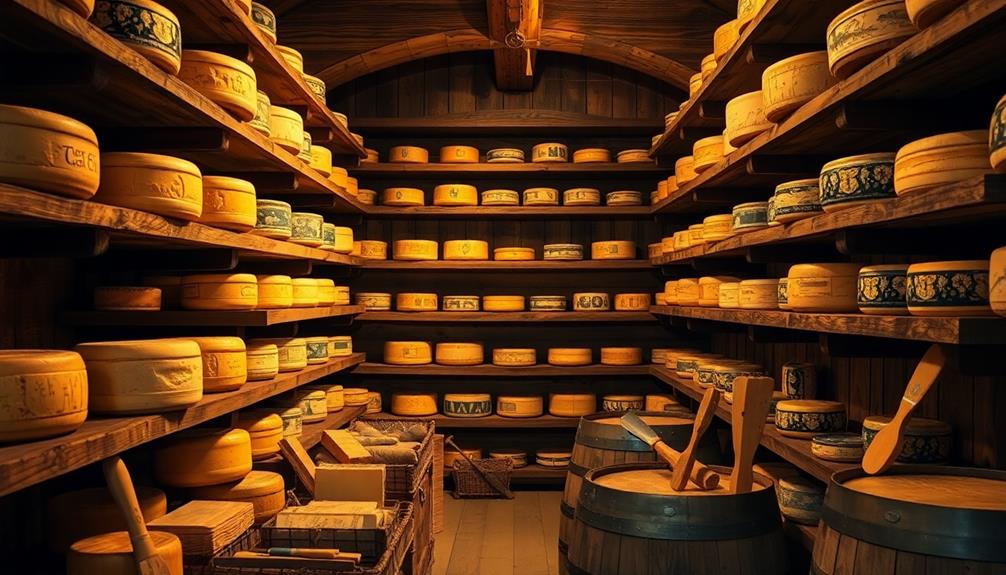The science of perfectly aged cheese combines meticulous processes that enhance flavors and textures. As cheeses age, they lose moisture, concentrating their taste and developing unique characteristics. Bacterial cultures and carefully controlled environments contribute to this transformation, whether through surface or interior ripening. You'll experience complex flavors—from the nutty richness of Gouda to the sharp bite of aged cheddar—each offering its own story. The temperatures and humidity levels are vital, impacting the taste and aroma. There's so much more to explore about aging techniques and the health benefits of aged cheese—stick around to uncover the details!
Key Takeaways
- Aged cheese develops complex flavors due to specific bacterial cultures and controlled aging conditions like temperature and humidity.
- The aging process involves moisture loss, concentrating flavors and enhancing the texture of the cheese.
- Surface-ripening and interior ripening techniques significantly influence the final flavor and texture of aged cheeses.
- High humidity levels and controlled temperatures are essential for optimal aging, promoting microbial activity and flavor development.
- Nutritional benefits of aged cheese include high protein content, essential vitamins, and digestive advantages for lactose-intolerant individuals.
Why Is Cheese Aged
Aged cheese, like a fine wine, develops complex flavors that fresh varieties simply can't match. The process of aging cheese transforms its flavor and texture, creating unique profiles that are highly sought after.
Take aged cheddar, for example; its rich, sharp taste is a direct result of careful aging techniques used by cheesemakers. Similarly, the slow cooking methods used in dishes like Red-Braised Pork Belly also highlight the significance of time in developing rich flavors.
During the cheesemaking process, specific bacterial or mold cultures are often introduced to influence the final product's characteristics. These microorganisms play a vital role in developing flavors, breaking down proteins and fats over time.
You'll notice that the storage conditions, including temperature and humidity, are meticulously controlled to either accelerate or decelerate the aging cheese process, allowing cheesemakers to craft the desired outcome.
The art and science behind aging cheese also involve diverse techniques, such as surface-ripening and interior ripening. Each method contributes to distinct flavors and textures, showcasing the intricate journey from milk to complex culinary delight.
Aging Process and Techniques
The aging process of cheese is a delicate dance between science and artistry, where factors like temperature and humidity are meticulously controlled to create the perfect environment for flavor development. Different aging techniques, such as surface-ripening and interior ripening, greatly influence the texture of the cheese and flavor profiles.
Here's a quick look at some key techniques and their effects:
| Aging Technique | Effect on Cheese |
|---|---|
| Surface-Ripening | Develops a soft, creamy rind |
| Interior Ripening | Enhances nutty, complex flavors |
| Controlled Humidity | Prevents excessive moisture loss |
| Bacterial Cultures | Introduces specific flavors |
| Temperature Control | Affects texture and aroma |
Moisture loss plays a vital role during the aging process, intensifying flavor concentration and altering texture. Aged cheeses often become denser and more complex than their younger counterparts. Additionally, the introduction of specific bacterial cultures helps create unique flavor profiles, emphasizing the blend of art and science in cheesemaking. Ultimately, the aging process transforms cheese into a rich tapestry of taste and texture that delights the palate.
Changes During Aging
As cheese matures, several notable changes occur that enhance its flavor and texture. During the cheese aging process, moisture loss takes place, concentrating the taste components and intensifying the overall flavor. This loss of moisture is essential; it's what transforms a young cheese into a complex delight.
Enzymes and microbes work tirelessly to break down lactose into lactic acid, contributing to the cheese's unique flavor profile. Just like the traditional dishes in Brazilian cuisine, where various ingredients meld together to create rich layers of taste, the aging process of cheese similarly enhances its complexity.
As aging continues, the buildup of amino acids leads to distinct and complex taste variations, especially in older varieties like Parmesan. You might even notice the development of crunchy tyrosine crystals, which form as proteins break down over time. These crystals not only add an interesting visual element but also enhance the texture experience.
The aging process also alters the texture of cheese considerably. Depending on the type and aging conditions, you'll find that some cheeses become firmer, while others may develop a creamier consistency.
This transformation is part of what makes aged cheeses so appealing, inviting you to savor the layers of flavor and texture that each bite offers. Enjoy discovering how these changes shape your cheese experience!
Common Aged Cheeses
Numerous cheeses are celebrated for their aging process, each offering a unique flavor and texture that evolves over time. Among the common aged cheeses, cheddar stands out with its wide range of flavors, from mild to sharp, depending on its aging period. Some cheddars mature for over two years, developing a robust and complex taste that many cheese lovers adore.
The transformation of flavors during the aging process echoes the deep culinary traditions found in various cultures, such as the rich history of Asian Cuisine.
Another popular option is Gouda. This Dutch cheese is often aged to various intensities, resulting in a rich, nutty flavor with caramel-like sweetness as it matures. The aging process transforms Gouda into a delightful treat that pairs well with a variety of foods.
Parmesan is another remarkable aged cheese, known for its hard, granular texture and complex flavor. Typically aged for 12 months to several years, it becomes a staple in many kitchens, perfect for grating over pasta or salads.
Lastly, consider blue cheeses like Roquefort or Gorgonzola. They age to develop their characteristic blue veins and tangy flavors, with some varieties maturing for over a year.
Each of these common aged cheeses brings its own distinct personality to your cheese board.
Surface-Ripening vs. Interior Ripening
When it comes to cheese aging, understanding the difference between surface-ripening and interior ripening is key to appreciating their unique flavors and textures.
Surface-ripening involves aging cheese from the outside inward. This method often develops distinctive rinds, enhancing the cheese's flavor and texture. Cheeses like Uplands Rush Creek Reserve are prime examples of this technique, where washes or brine promote the growth of specific bacteria and molds on the rind, creating bold flavor profiles.
Curiously, much like the careful preparation of Italian dishes such as Agnolotti, the craftsmanship in cheese aging showcases regional culinary skills.
On the other hand, interior ripening occurs from the inside out. Cheeses such as Swiss are typically left rindless, allowing for a smoother, creamier texture in the center while preventing surface aging. A common practice in this method is bandaging, where cheeses are wrapped to limit moisture loss.
This technique helps create distinct flavor profiles throughout the cheese, ensuring a consistent taste.
Ultimately, the choice between surface-ripening and interior ripening greatly influences the final product. Surface-ripened cheeses showcase pronounced rind flavors, while interior-ripened cheeses deliver a harmonious blend of flavors within, giving you a rich variety to enjoy in your cheese-tasting adventures.
Impact of Temperature and Humidity
When it comes to aging cheese, the right temperature and humidity can make all the difference.
The process is somewhat analogous to aging certain foods, such as slow-cooked pork belly, where controlled environments enhance flavors and textures.
You need to maintain a high humidity level around 85-90% to keep the cheese from drying out and losing its texture.
Keeping the temperature at about 50°F guarantees the microbial activity thrives, which is key for developing those rich flavors you love.
Optimal Aging Conditions
Creating the perfect environment for aging cheese involves carefully controlling temperature and humidity. Most cheeses thrive at about 50°F (10°C), where the right balance of enzymatic and microbial activity occurs.
You'll want to maintain high humidity levels, typically around 80-90%, to prevent excessive moisture loss. This is vital for preserving texture and enhancing flavor. Just like the Loaded Baked Potato, which benefits from the right conditions for ideal taste, aged cheese also requires specific environments to develop its best qualities.
- The rich aroma of cheese maturing slowly in a cool, humid cellar.
- The delicate crust forming on the surface, hinting at complex flavors developing within.
- The satisfying crunch of aged cheese, a result of skilled aging practices.
Cheesemakers use these ideal aging conditions to refine their techniques over the years. Monitoring humidity and temperature is fundamental; too much fluctuation can lead to spoilage or off-flavors, ruining the final product.
As moisture loss occurs, flavors concentrate, and the cheese takes on its unique characteristics. By creating a consistent aging environment, you guarantee that each wheel of cheese reaches its full potential, delivering an exquisite taste experience.
Role of Humidity
Humidity plays an essential role in the aging process of cheese, directly influencing texture and flavor development. Ideally, you want to maintain humidity levels around 80-90%. This prevents the cheese from drying out, helping to preserve its moisture and ensuring a creamy, desirable texture.
If humidity dips too low, you risk creating a crumbly cheese that lacks character. Just as the quality of ingredients is critical in Japanese cuisine, such as in dishes like Dorayaki (Red Bean Pancake), the conditions of cheese aging can greatly impact the final product.
Temperature also plays an important role, with most cheeses thriving at about 50°F. This temperature encourages beneficial bacteria and enzymes to work their magic, enhancing flavor complexity. However, it's crucial to keep both humidity and temperature consistent. Fluctuations can lead to undesirable textures, spoilage, or a compromised rind quality.
The materials in your aging environment can further influence humidity levels. For instance, aging cheese on wood can contribute unique flavor profiles, adding another layer to your cheese's character.
Master cheesemakers spend years refining their techniques, closely monitoring moisture loss and adjusting conditions to achieve their specific aging results. By understanding the importance of humidity in the aging process, you can elevate your cheese-making skills and produce perfectly aged cheese.
Aging Environment Effects
When it comes to aging cheese, humidity levels can make a huge difference in flavor and texture. The right aging environment is essential, much like the traditional methods used in Muamba De Galinha, where specific ingredients and cooking techniques create a rich culinary experience.
You'll find that the right materials, like specific woods, also play a key role in enhancing those unique characteristics. Understanding these factors can help you appreciate the complexity behind your favorite aged cheeses.
Impact of Humidity Levels
The aging environment plays an essential role in developing a cheese's flavor and texture, particularly through humidity levels.
Maintaining the right humidity is vital for aging cheese effectively. High humidity, around 85%, helps preserve moisture and prevents undesirable texture changes. This balance keeps the cheese rind intact, allowing unique flavors and textures to flourish.
Just as traditional Ethiopian dishes like Yekolo emphasize the importance of texture and flavor, aging cheese requires a careful approach to environmental factors.
Consider the following:
- Brie and Camembert: These cheeses thrive in humid conditions, developing their characteristic soft, creamy textures.
- Parmesan: This hard cheese requires lower humidity to encourage moisture evaporation, leading to a firmer texture and concentrated flavor.
- Flavor profiles: The aging environment, including humidity and specific woods, can greatly enhance aromatic qualities.
Role of Aging Materials
In the world of cheese aging, the materials used in the environment play an essential role in shaping flavor and texture. The choice of aging surface, such as spruce wood or stone, can impart unique characteristics to the cheese. For instance, spruce wood adds a nutty aroma, enhancing the overall taste profile.
Humidity control is vital, as high humidity levels—around 85% to 90%—are ideal for best cheese development. The type of wood used can affect moisture retention and the final texture of the cheese. Temperature also plays a significant role; most cheeses thrive at approximately 50°F, influencing biochemical reactions that contribute to flavor and texture.
Here's a quick overview of how these factors interact in the aging environment:
| Factor | Impact on Cheese |
|---|---|
| Humidity Control | Affects moisture retention |
| Temperature | Influences biochemical reactions |
| Aging Surface | Imparts unique flavors and textures |
Aged Cheese Pairings
Aged cheese pairings can elevate your tasting experience, bringing out the unique flavors of both the cheese and its companions. When you craft a cheese board, consider the delightful combinations that enhance the richness of aged cheeses.
For instance, aged cheddar cheese shines when paired with sweet fruits like apples and pears, creating a perfect contrast to its sharp profile. Additionally, a invigorating glass of Txakoli (White Wine) can complement the sharpness of cheddar, providing a lively counterpoint that enhances your palate.
- The nutty richness of aged Gouda harmonizes beautifully with fresh pears, adding a delightful dimension.
- Strong cheddar varieties find their match in hearty breads, balancing their intense flavors perfectly.
- High-acidity wines, such as Champagne and Cabernet Sauvignon, elevate aged cheese, enhancing its complex taste.
If you're venturing into robust cheeses like Parmigiano-Reggiano, opt for full-bodied wines like Barolo or Zinfandel. These pairings create a harmonious flavor experience that reflects the Science of Aging in cheese.
Nutritional Benefits of Aged Cheese
Aged cheese packs a punch when it comes to nutrition.
You'll find it rich in calcium, which helps keep your bones strong, and loaded with protein for muscle repair.
Plus, the beneficial bacteria in aged cheese can support your digestion, making it a tasty choice for your gut health.
Calcium for Bone Health
When it comes to maintaining strong bones, aged cheese stands out as a remarkable source of calcium. With approximately 200-300 mg of calcium per ounce, it's essential for preventing osteoporosis and supporting overall bone health. The aging process concentrates calcium by reducing moisture, making aged cheeses like Parmesan and Cheddar even more beneficial.
Imagine adding these delicious options to your diet:
- Creamy Cheddar: Perfect for melting over vegetables or enjoying in a grilled cheese.
- Savory Parmesan: A flavorful topping for pasta, enhancing both taste and nutrition.
- Nutty Gruyère: A delightful addition to your cheese board, rich in both flavor and calcium.
Regularly incorporating aged cheeses into your meals can help you reach the recommended daily intake of about 1,000 mg of calcium for most adults.
Plus, these cheeses often come packed with other nutrients like protein and vitamin D, which work together to enhance calcium absorption.
By choosing aged cheese, you're making a tasty choice that bolsters your bone health and keeps you feeling strong.
Protein for Muscle Repair
While strong bones benefit from calcium, protein plays an essential role in muscle repair and growth, and aged cheese is an excellent source. Varieties like Parmesan pack about 35 grams of protein per 100 grams, making it a fantastic choice for increasing your protein intake. The aging process reduces moisture, concentrating the protein content, which is especially beneficial for athletes and active individuals.
Aged cheese also provides essential amino acids, vital for muscle recovery after exercise. These amino acids help repair muscle fibers that break down during workouts, promoting faster recovery and growth.
Additionally, the fermentation process enhances the bioavailability of protein, meaning your body absorbs it more effectively.
Incorporating aged cheese into your diet not only delivers high-quality protein but also offers essential nutrients like calcium and vitamins that support overall health.
Digestive Benefits From Bacteria
Enjoying aged cheese can really boost your digestive health thanks to the beneficial bacteria it contains. These bacteria play an essential role in promoting a healthy gut microbiome, which is crucial for effective digestion.
If you're lactose intolerant, you're in luck! The fermentation process during aging considerably reduces the lactose levels, making many aged cheeses suitable for your diet.
Imagine indulging in:
- A rich, creamy piece of aged cheddar, melting in your mouth
- A crumbly, tangy blue cheese, bursting with flavor
- A nutty, fragrant Gruyère, perfect for elevating your dishes
Not only do these delightful aged cheeses enhance your meals, but they also pack a nutritional punch.
They're rich in protein, which supports muscle repair and growth, and high in calcium for strong bones. Plus, they contain essential vitamins like A, B12, and D, which contribute to your overall wellness.
Global Varieties of Aged Cheese
Aged cheese offers a delightful exploration of flavors and textures from around the world. You'll find an impressive variety of cheeses, each shaped by the unique process of aging cheese.
Take Cheddar, for instance, which originated in England. Its sharp and tangy flavor intensifies with age, making it one of the most popular cheeses globally.
Then there's Gouda from the Netherlands, known for its nutty richness that varies with aging—aged Gouda can even have a caramel-like sweetness.
In Italy, Parmigiano-Reggiano reigns supreme as the "king of cheeses." With a hard, granular texture, its complex flavors develop over a minimum of 12 months.
Don't overlook Roquefort, a French blue cheese celebrated for its creamy texture and tangy taste, enhanced by the blue veins created by different bacterial molds during its aging process.
Finally, Gruyère from Switzerland offers a sweet, nutty flavor, perfect for fondue, and ages from five months to a year, with longer aging yielding even more intense flavors.
Frequently Asked Questions
What Happens Chemically When Cheese Ages?
When cheese ages, it undergoes chemical changes like moisture loss and protein breakdown. You'll notice flavors intensifying as fats and proteins transform, creating unique characteristics that enhance both taste and texture in the final product.
Is It True That the Older the Cheese the Better?
It's not always true that older cheese is better. Your taste preferences play a huge role. Some might enjoy the intense flavors of aged varieties, while others may prefer the creaminess of younger cheeses.
How Does Aged Cheese Not Go Bad?
Aged cheese doesn't spoil easily because it's undergone a thoughtful transformation. Its lower moisture, natural protective rinds, and careful salt balance create an environment where harmful bacteria struggle to thrive, ensuring your cheese remains delightful.
How Do They Age Cheese for 10 Years?
To age cheese for 10 years, you maintain precise temperature and humidity levels, monitor conditions closely, and guarantee proper airflow. This careful process allows flavors to develop while preventing spoilage and maintaining quality throughout aging.
Conclusion
In the delightful world of aged cheese, you're not just savoring flavors; you're experiencing a complex chemistry of care and craft. The aging process transforms textures and tantalizes taste buds, bringing forth a symphony of sensations. So, whether you're pairing a pungent piece with a perfect wine or enjoying it solo, remember that each bite bursts with benefits. Immerse yourself in the diverse delights of aged cheese, and you'll discover a delicious journey worth taking!









